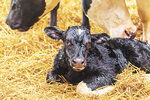


Editor’s note: Dairy Star aims to provide our readers with a closer look into relevant topics to today’s dairy industry. Through this series, we intend to examine and educate on a variety of topics. If you have an idea for a topic to explore in a future issue, send Stacey an email.
In 2022, a genetic defect was discovered in Holstein dairy cattle. Calves suffering from this defect are unable to stand or lose the ability to stand shortly after birth. Aside from the initial inability to stand, animals appear healthy. However, shortly thereafter, secondary problems, such as pneumonia, become a problem.
Formerly called calf recumbency, this genetic defect is now referred to as Early Onset Muscle Weakness Syndrome, or MW. The frequency of the defective allele in the current Holstein population is estimated to be around 5%.
“The timing of when symptoms manifest varies from one calf to the next, but in all cases, affected animals cannot stand up,” said Chad Dechow, associate professor of dairy cattle genetics at Pennsylvania State University. “In most cases, the problem is detected soon after the calf is born.”
Early Onset Muscle Weakness Syndrome was brought to Dechow’s attention in mid-2020 by veterinarians who had observed the condition on two farms beginning in late 2019. The vets noticed a mysterious condition in which animals could not stand at birth or shortly thereafter and most did not survive past 6 weeks of age. No neurologic, infectious or metabolic abnormalities were found in the calves.
Suspecting it may be a genetic condition, the veterinarians called upon Dechow’s expertise. After extensive study of DNA from the affected calves as well as their unaffected relatives, Dechow and his team determined that affected animals had two copies of a mutation in a gene on chromosome 16. This gene is responsible for the formation of calcium channels that help control muscle movement.
It is believed that both the sire and dam must be carriers for recumbency to be expressed in calves. However, MW is different from other genetic defects found in cattle because the mutation does not guarantee the calf will be affected. It is a trait that demonstrates incomplete penetrance, which means an animal can have two copies of the defective gene but not suffer from MW.
“Part of the challenge with this condition is that some animals have two copies of the defective allele and appear to be normal or relatively normal,” Dechow said. “We have no idea how some animals can have the condition genetically but not have it phenotypically.”
Dechow said that probably less than half of the calves who get the genetic condition survive. But a number of them do, and it is not a trivial number, he said.
“In humans, mutations in this gene oftentimes are dominant,” Dechow said. “You might only get one copy but still end up inheriting it. For the most part, we don’t think that is the case for this condition in cattle.”
As of February, Holstein Association USA is recognizing Early Onset Muscle Weakness Syndrome as an undesirable genetic condition in the breed. The decision was made at the association’s board meeting in November 2023.
“Breed associations work closely with others to confirm the mode of inheritance of a new genetic condition as well as to obtain an estimate of the frequency of the defected allele in the current population, an accurate description of the defect and whether all homozygous affected animals exhibit the condition in the same way,” said Dr. Tom Lawlor, Holstein Association USA’s executive director of research and development. “After a thorough review of all available information, it was determined that MW meets the criteria of being declared as an official undesirable genetic disorder.”
Direct gene test results for MW will be labeled on Holstein pedigrees and other products where recognized genetic conditions are displayed. The following codes will be used to designate animals with official gene test results on file: TE, tested free of MW; MW, heterozygous carrier; and MW2, homozygous carrier.
After the genetic discovery was made, the Holstein Association put out a breed-wide request asking individuals to genotype their animals to get a read on the frequency of the problem. They received genotypes on over 12,000 animals.
“From that, we determined the frequency was around 5%,” Lawlor said. “It was high enough that we want to reduce it but not so high that it was considered a major disaster.”
Dechow and his team traced the defect to an influential Holstein sire born in 2008, Roylane Socra Robust. Robust was present in the paternal and maternal lineages of all affected calves Dechow tested. Robust’s son, Seagull-Bay Supersire, born in 2010, is also a MW carrier. Researchers identified one of the first carriers of the mutation to be Southwind Bell of Bar-Lee, born in 1984.
Dechow said a cow can be bred to a carrier, but she should be tested first to ensure she is not a carrier so the mating will not propagate the condition. Unless they are exceptional bulls, carriers will be weeded out by A.I. studs, Dechow said.
The Holstein Association has provided a list of tested bulls on their website, noting carriers.
“Around 550 bulls are either a carrier or have two copies of the condition,” Dechow said. “Is this worrisome? Yes and no. Now that we have a genetic test for it, all Holstein A.I. bulls will be tested. Also, it takes two copies to cause this. Because of that, it’s something we can get control of pretty quickly.”
Dechow said that based on this information, it appears that about 9% of bulls are carriers, meaning they have one copy of the mutation.
“The key is to avoid a carrier-to-carrier mating,” Lawlor said. “A.I. companies are making that information easily accessible now that everybody knows the status of the animals. Over the next 2-3 years, breeders should be paying attention to avoid breeding carriers to other carriers, and it will drop off quickly. We will see a rapid decrease in frequency when doing that.”
Dechow helped develop a genetic test to identify a carrier. He said there are two types of tests available. The first is a gene test for the exact mutation. This test can be conducted by mailing the lab a few strands of hair, blood or tissue.
“If you are interested in marketing genetics, this is the test you would use,” Dechow said.
This test would be used on breeding-age animals to assist in mating decisions. It might also be used to confirm MW in a calf that cannot stand.
The second is a haplotype call which is automatically run any time a genomic test is done.
“The problem is that this test is not very accurate,” Dechow said. “It’s OK from a sense that it gives you an idea of how much of your herd may or may not be affected, but it does give a lot of false negatives and false positives.”
Instead, Dechow said most farmers are going to rely on the sires they select and avoid sires that are carriers.
“Now that we have a test to reduce MW and breed against it, we can hopefully use this tool to get rid of this defect or to get it to a low level quickly,” Dechow said. “The condition will never completely disappear as we have genetic recessives from decades ago that randomly crop up, but this will drop to a really low level — less than 1% — a decade from now.”
Comments
No comments on this item Please log in to comment by clicking here